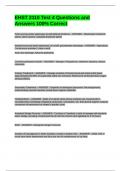EHST 2110 Test 4 Questions and
Answers 100% Correct
Point sources-enter waterways at well-defined locations: - ANSWER - Wastewater treatment
plants, storm sewers, industrial treatment plants
Nonpoint sources-enter waterways via runoff, groundwater discharge: - ANSWER - Agriculture,
Construction activities, Urban runoff,
Acid mine drainage, Airborne pollutants.
Common pollutants include: - ANSWER - Nitrogen, Phosphorus, sediment, bacteria, various
chemicals
Primary Treatment: - ANSWER - Sewage consists of human feces and urine at this point.
Approximately 50-65% of suspended solids are removed. Referred to as Biochemical oxygen
demand (BOD).
Secondary Treatment: - ANSWER - Depends on biological processes. Microorganisms,
predominately aerobic bacteria, break down organic materials.
Trickling filters: - ANSWER - Beds of crushed stone whose surfaces are covered with a
microbial slime consisting of bacteria, protozoan, nematodes, etc. that absorb organic material:
conversion of ammonium to nitrate in aerobic zone.
Activated Sludge Process: - ANSWER - Consists of "seeding" a tank of sewage with bacteria-
laden sludge, pumping compressed the air into the mixture and agitating for 4-10 hours.
BNR: - ANSWER - biological nitrogen removal.
Number of hog lagoons in North Carolina, mostly in eastern NC: - ANSWER - 3,800, 550 of
those have been abandoned and lack any sort of maintenance or up keep
, Controlled Drainage: - ANSWER - Water management practice that utilizes water control
structures such as a flash board riser to adjust the drainage outlet elevation of the area draining
to the water control structure and outlet.
Advanced wastewater Treatment (Tertiary Treatment): - ANSWER - BNR
Biosolids Management: - ANSWER - "sludge" difficult for large urban areas
Septic Tank: - ANSWER - Anaerobic environment, settling tank
Drainfield trench: - ANSWER - Aerobic environment where wastewater infiltrates the soil.
The water cycle is much different in urban settings as compared to natural settings. - ANSWER
- In urban settings, there is much more impervious surfaces like parking lots, rooftops, and
roads.
Stilling Basin: - ANSWER - Dissipates energy, and allows sediment to settle. Clearer liquid
discharges. Typically store water for 24-48 hours.
Rain Gardens: - ANSWER - Inlet, Mulch, Plants, Forebay, outlet, Bowl
Inlet: - ANSWER - Where water enters rain garden- swallow, pipe,
Mulch: - ANSWER - Provides organic matter for plant growth, binds pollutants, carbon source of
denitrification, looks nice
Plants: - ANSWER - Uptake nutrients and water, look nice, wildlife habitat, stabilize soil
Forebay: - ANSWER - For larger gardens, dissipate energy, settle out some sediment
Outlet: - ANSWER - Can be structure or overflow, where excess water exits




